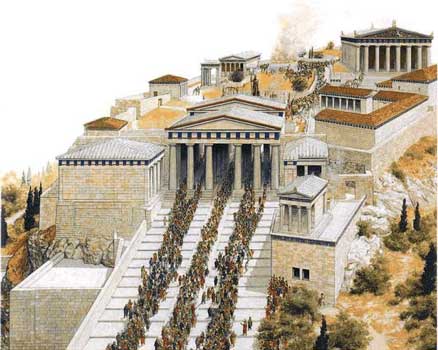As the summer comes to full swing, the archaeological season comes to a close at many ancient sites. As such, reports of these finds are now frequent and some are quite interesting!
2016 Pteria excavations (central Turkey)
The 'Pteria Ancient City' is located near the village of Şahmuratlı in Yozgat province's Sorgun district in central Turkey. An excavation team of 45 under the supervision of the American archaeologist Scott Branting discovered significant remains in the ruins of the ancient city this season.
According to Branting, this year's excavations mainly focused on the northern part of the ancient city, focusing on the ruins of several houses. According to the archaeologists, the city block which they excavated this year is only one of 757 city blocks in the ancient city. A team of 30 academics and students from various universities, together with 15 villagers from Şahmuratlı, participated in the excavations.
The vice president of the excavations, Yasemin Özarslan of Koç University's Department of Archaeology, said they launched this year's excavations on May 15 and stressed that they discovered very important findings during the dig. Özarslan said:
"We excavated some buildings and open air spaces located in the northern part of the city. The archaeological team managed to finish the dig on a building with columns. Avenues and roads furnished with stones have been unearthed this year. We successfully unearthed some of these roads. Some objects from 700 B.C., meaning belonging to the Iron Age, have been discovered."
2016 Yeronisos Island excavations
Yeronisos, or 'Sacred Island, is 12,000 square meters of calcareous rock just off the coast of western Cyprus. The archaeological expedition to the island was under the direction of Joan Breton Connelly, Professor of Classics and Art History at New York University. Eight undergraduates and graduate students from New York University participated in the excavation field school.
Excavations within the island sanctuary have yielded significant ostraca and inscriptions dating to the final years of Ptolemaic rule in Cyprus. Angelos Chaniotis, Professor at Princeton University, head of a team of eminent epigraphists, came out to study the material, assisted by Dr. Benjamin Wieland of the University of Fribourg.
A second major focus of the 2016 season was the architecture of Yeronisos island buildings. Professor Pieter Broucke from Middlebury College in Vermont began the study of ashlar blocs, architectural members and architectural moldings discovered on the island. The architectural fragments belonged to a small Ionic temple that once stood on the westernmost cliff of the island. The temple rested on a podium measured 8.47 m. in width and it was built from finely dressed limestone blocks, carefully plastered to resemble marble. It had a central doorway framed by engaged Ionic columns and carried a small Ionic entablature with horizontal geison. The roof was gabled, had pediments at its short ends and solid walls on all four sides, terminating in an epikranitis course with an Ionic molding on top.
PhD student Luca Cherstich joined the team for study of local rock cut tombs in an effort to understand Yeronisos within the broader context of the community living just opposite on the mainland during the Hellenistic period. Architect Richard Anderson continued work on the 3-D digital survey of the island’s architectural remains.
Prof. Jolanta Mlynarczyk of the University of Warsaw undertook the study of the Yeronisos pottery while Dr. Mariusz Burdajewicz completed work on his publication on the Geronisos glass finds. Dr. Paul Croft of the Lemba Archaeological Field Station studied animal bones collected from the island.
2016 Pteria excavations (central Turkey)
The 'Pteria Ancient City' is located near the village of Şahmuratlı in Yozgat province's Sorgun district in central Turkey. An excavation team of 45 under the supervision of the American archaeologist Scott Branting discovered significant remains in the ruins of the ancient city this season.
According to Branting, this year's excavations mainly focused on the northern part of the ancient city, focusing on the ruins of several houses. According to the archaeologists, the city block which they excavated this year is only one of 757 city blocks in the ancient city. A team of 30 academics and students from various universities, together with 15 villagers from Şahmuratlı, participated in the excavations.
The vice president of the excavations, Yasemin Özarslan of Koç University's Department of Archaeology, said they launched this year's excavations on May 15 and stressed that they discovered very important findings during the dig. Özarslan said:
"We excavated some buildings and open air spaces located in the northern part of the city. The archaeological team managed to finish the dig on a building with columns. Avenues and roads furnished with stones have been unearthed this year. We successfully unearthed some of these roads. Some objects from 700 B.C., meaning belonging to the Iron Age, have been discovered."
2016 Yeronisos Island excavations
Yeronisos, or 'Sacred Island, is 12,000 square meters of calcareous rock just off the coast of western Cyprus. The archaeological expedition to the island was under the direction of Joan Breton Connelly, Professor of Classics and Art History at New York University. Eight undergraduates and graduate students from New York University participated in the excavation field school.
Excavations within the island sanctuary have yielded significant ostraca and inscriptions dating to the final years of Ptolemaic rule in Cyprus. Angelos Chaniotis, Professor at Princeton University, head of a team of eminent epigraphists, came out to study the material, assisted by Dr. Benjamin Wieland of the University of Fribourg.
A second major focus of the 2016 season was the architecture of Yeronisos island buildings. Professor Pieter Broucke from Middlebury College in Vermont began the study of ashlar blocs, architectural members and architectural moldings discovered on the island. The architectural fragments belonged to a small Ionic temple that once stood on the westernmost cliff of the island. The temple rested on a podium measured 8.47 m. in width and it was built from finely dressed limestone blocks, carefully plastered to resemble marble. It had a central doorway framed by engaged Ionic columns and carried a small Ionic entablature with horizontal geison. The roof was gabled, had pediments at its short ends and solid walls on all four sides, terminating in an epikranitis course with an Ionic molding on top.
PhD student Luca Cherstich joined the team for study of local rock cut tombs in an effort to understand Yeronisos within the broader context of the community living just opposite on the mainland during the Hellenistic period. Architect Richard Anderson continued work on the 3-D digital survey of the island’s architectural remains.
Prof. Jolanta Mlynarczyk of the University of Warsaw undertook the study of the Yeronisos pottery while Dr. Mariusz Burdajewicz completed work on his publication on the Geronisos glass finds. Dr. Paul Croft of the Lemba Archaeological Field Station studied animal bones collected from the island.














